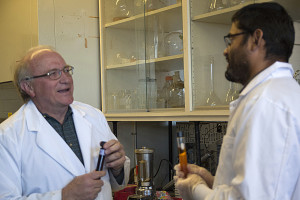UNR professor converting weed to biofuel

Glenn Miller and Bishnu Neupane hold the final biofuel product based on the gumweed plant. Photo/Whip Villarreal
By Mike Wolterbeek
A UNR professor is leading the effort to convert roadside gumweed into biofuel, which could help contribute to fuel supplies for the military.
“The plant grindelia squarosa, known as curly top gumweed, has extractable hydrocarbons with the potential use as a biodiesel or biomaterials crop,” Glenn Miller r, a professor in the college of agriculture, biotechnology and natural resources, said. “Gumweed is native in Nevada and grows on the side of freeways and, more importantly, is an arid land crop that requires less water than other substitutes like alfalfa. Alfalfa takes 5 feet of water to grow, while gumweed uses no more than a foot of water.”
Gumweed was planted at the university’s Valley Road Field Laboratory and the Main Station Field Laboratory using minimal water and fertilizer resources. After growing and harvesting the gumweed, it went through biomass processing where it was broken down to liquid that smells like tar.
“We are looking at breaking it down because it uses less water and it’s already acclimated to Nevada conditions,” Miller said. “It would be beneficial generating this arid-land crop because it doesn’t compete with food or animal feed. The primary resource for diesel fuel is soy beans and ethanol for corn which are always in direct competition with food.”
The final biofuel product from the chemical engineering process can produce up to 122 gallons per acre on a biennial basis on the semi-arid lands of Nevada. The crops would require minimum inputs of nutrients and water and have the potential to be converted into jet fuel, which has garnered the interest from the military – the largest fuel consumer in the United States.
Miller said the U.S. Navy is interested in using the biofuel as jet fuel. The project received $500,000 in grant funding from the U.S. Department of Agriculture and has the potential to supply up to 20 percent of fuel demand for the military.
“It is estimated that if even 10 percent of sagebrush-covered lands in Nevada are used to grow gumweed for aviation biofuels, 400 to 600 million gallons per year of jet biofuels could be produced,” Hongfei Lin, a collaborator from the college of engineering, said. “That’s definitely incredible. There’s lots of potential.”
Lin, a professor of chemical and materials engineering is working on the project with Miller to identify a catalyst that can be used to convert biomass into fuel using an unconventional approach to biofuel production. Instead of adding hydrogen to biomass, Lin is exploring a more cost-effective manner using an oxidation process.
In nature, Oxidation occurs when substances come in contact with oxygen molecules. For example, oxidation occurs when a freshly cut apple turns brown, a bicycle fender becomes rusty or a copper penny turns green. Lin is trying to mimic the natural process for biomass deconstruction when converting the gumweed into biomatter for jet fuel.
Lin will be speaking at the American Institute of Chemical Engineers annual meeting in Salt Lake City where the group’s project is being presented. AIChE is the world’s leading organization for chemical engineering professionals which promotes excellence and advancement in the practice.
Mike Wolterbeek works for UNR.


